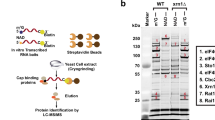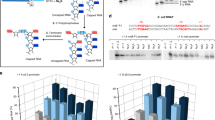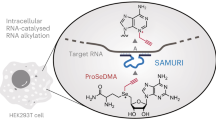Abstract
We recently demonstrated that mammalian cells harbor nicotinamide adenine dinucleotide (NAD)-capped messenger RNAs that are hydrolyzed by the DXO deNADding enzyme. Here, we report that the Nudix protein Nudt12 is a second mammalian deNADding enzyme structurally and mechanistically distinct from DXO and targeting different RNAs. The crystal structure of mouse Nudt12 in complex with the deNADding product AMP and three Mg2+ ions at 1.6 Å resolution provides insights into the molecular basis of the deNADding activity in the NAD pyrophosphate. Disruption of the Nudt12 gene stabilizes transfected NAD-capped RNA in cells, and its endogenous NAD-capped mRNA targets are enriched in those encoding proteins involved in cellular energetics. Furthermore, exposure of cells to nutrient or environmental stress manifests changes in NAD-capped RNA levels that are selectively responsive to Nudt12 or DXO, respectively, indicating an association of deNADding to cellular metabolism.
This is a preview of subscription content, access via your institution
Access options
Access Nature and 54 other Nature Portfolio journals
Get Nature+, our best-value online-access subscription
$29.99 / 30 days
cancel any time
Subscribe to this journal
Receive 12 print issues and online access
$259.00 per year
only $21.58 per issue
Buy this article
- Purchase on Springer Link
- Instant access to full article PDF
Prices may be subject to local taxes which are calculated during checkout






Similar content being viewed by others
Data availability
The data that support the findings of this study are available from the corresponding author upon reasonable request. Sequencing data have been deposited in the Gene Expression Omnibus (GEO) database (accession nos. GSE90884 (DXO-KO) and GSE110801 (N12-KO)). The atomic coordinates have been deposited at the Protein Data Bank (PDB entry 6O3P).
References
Chen, Y. G., Kowtoniuk, W. E., Agarwal, I., Shen, Y. & Liu, D. R. LC/MS analysis of cellular RNA reveals NAD-linked RNA. Nat. Chem. Biol. 5, 879–881 (2009).
Cahova, H., Winz, M. L., Hofer, K., Nubel, G. & Jaschke, A. NAD captureSeq indicates NAD as a bacterial cap for a subset of regulatory RNAs. Nature 519, 374–377 (2015).
Bird, J. G. et al. The mechanism of RNA 5′ capping with NAD+, NADH and desphospho-CoA. Nature 535, 444–447 (2016).
Malygin, A. G. & Shemyakin, M. F. Adenosine, NAD and FAD can initiate template-dependent RNA synthesis catalyzed by Escherichia coli RNA polymerase. FEBS Lett. 102, 51–54 (1979).
Julius, C. & Yuzenkova, Y. Bacterial RNA polymerase caps RNA with various cofactors and cell wall precursors. Nucleic Acids Res. 45, 8282–8290 (2017).
Walters, R. W. et al. Identification of NAD+ capped mRNAs in Saccharomyces cerevisiae. Proc. Natl Acad. Sci. USA 114, 480–485 (2017).
Jiao, X. et al. 5′ end nicotinamide adenine dinucleotide cap in human cells promotes RNA decay through DXO-mediated deNADding. Cell 168, 1015–1027.e10 (2017).
Frick, D. N. & Bessman, M. J. Cloning, purification, and properties of a novel NADH pyrophosphatase. Evidence for a nucleotide pyrophosphatase catalytic domain in MutT-like enzymes. J. Biol. Chem. 270, 1529–1534 (1995).
Luciano, D. J., Vasilyev, N., Richards, J., Serganov, A. & Belasco, J. G. Importance of a diphosphorylated intermediate for RppH-dependent RNA degradation. RNA Biol. 15, 703–706 (2018).
Mackie, G. A. Ribonuclease E is a 5′-end-dependent endonuclease. Nature 395, 720–723 (1998).
Zhang, D. et al. Structural basis of prokaryotic NAD-RNA decapping by NudC. Cell Res. 26, 1062–1066 (2016).
Srouji, J. R., Xu, A., Park, A., Kirsch, J. F. & Brenner, S. E. The evolution of function within the Nudix homology clan. Proteins 85, 775–811 (2017).
Abdelraheim, S. R., Spiller, D. G. & McLennan, A. G. Mammalian NADH diphosphatases of the Nudix family: cloning and characterization of the human peroxisomal NUDT12 protein. Biochem. J. 374, 329–335 (2003).
Carreras-Puigvert, J. et al. A comprehensive structural, biochemical and biological profiling of the human NUDIX hydrolase family. Nat. Commun. 8, 1541 (2017).
Jiao, X., Chang, J. H., Kilic, T., Tong, L. & Kiledjian, M. A mammalian pre-mRNA 5′ end capping quality control mechanism and an unexpected link of capping to pre-mRNA processing. Mol. Cell 50, 104–115 (2013).
Kiledjian, M. Eukaryotic RNA 5′-end NAD+ capping and deNADding. Trends Cell Biol. 28, 454–464 (2018).
Grudzien-Nogalska, E. & Kiledjian, M. New insights into decapping enzymes and selective mRNA decay. Wiley Interdiscip. Rev. RNA 8, e1379 (2017).
Grudzien-Nogalska, E., Bird, J. G., Nickels, B. E. & Kiledjian, M. ‘NAD-capQ’ detection and quantitation of NAD caps. RNA 24, 1418–1425 (2018).
Abdelraheim, S. R., Spiller, D. G. & McLennan, A. G. Mouse Nudt13 is a mitochondrial Nudix hydrolase with NAD(P)H pyrophosphohydrolase activity. Protein J. 36, 425–432 (2017).
Piccirillo, C., Khanna, R. & Kiledjian, M. Functional characterization of the mammalian mRNA decapping enzyme hDcp2. RNA 9, 1138–1147 (2003).
Song, M. G., Bail, S. & Kiledjian, M. Multiple Nudix family proteins possess mRNA decapping activity. RNA 19, 390–399 (2013).
Mildvan, A. S. et al. Structures and mechanisms of Nudix hydrolases. Arch. Biochem. Biophys. 433, 129–143 (2005).
Walters, R. W., Shumilin, I. A., Yoon, J. H., Minor, W. & Parker, R. Edc3 function in yeast and mammals is modulated by interaction with NAD-related compounds. G3 4, 613–622 (2014).
Hofer, K. et al. Structure and function of the bacterial decapping enzyme NudC. Nat. Chem. Biol. 12, 730–734 (2016).
Wang, Z. & Kiledjian, M. Functional link between the mammalian exosome and mRNA decapping. Cell 107, 751–762 (2001).
Song, M. G., Li, Y. & Kiledjian, M. Multiple mRNA decapping enzymes in mammalian cells. Mol. Cell. 40, 423–432 (2010).
Winz, M. L. et al. Capture and sequencing of NAD-capped RNA sequences with NAD captureSeq. Nat. Protoc. 12, 122–149 (2017).
Fulco, M. et al. Glucose restriction inhibits skeletal myoblast differentiation by activating SIRT1 through AMPK-mediated regulation of Nampt. Dev. Cell 14, 661–673 (2008).
Canto, C. et al. AMPK regulates energy expenditure by modulating NAD+ metabolism and SIRT1 activity. Nature 458, 1056–1060 (2009).
Canto, C. et al. Interdependence of AMPK and SIRT1 for metabolic adaptation to fasting and exercise in skeletal muscle. Cell Metab. 11, 213–219 (2010).
Chen, D. et al. Tissue-specific regulation of SIRT1 by calorie restriction. Genes Dev. 22, 1753–1757 (2008).
Raynes, R. et al. The SIRT1 modulators AROS and DBC1 regulate HSF1 activity and the heat shock response. PLoS ONE 8, e54364 (2013).
Li, Y., Ho, E. S., Gunderson, S. I. & Kiledjian, M. Mutational analysis of a Dcp2-binding element reveals general enhancement of decapping by 5′-end stem-loop structures. Nucleic Acids Res. 37, 2227–2237 (2009).
Li, Y., Song, M. G. & Kiledjian, M. Transcript-specific decapping and regulated stability by the human Dcp2 decapping protein. Mol. Cell Biol. 28, 939–948 (2008).
Arribas-Layton, M., Wu, D., Lykke-Andersen, J. & Song, H. Structural and functional control of the eukaryotic mRNA decapping machinery. Biochim. Biophys. Acta 1829, 580–589 (2013).
Li, Y. & Kiledjian, M. Regulation of mRNA decapping. Wiley Interdiscip. Rev. RNA 1, 253–265 (2010).
Frindert, J. et al. Identification, biosynthesis, and decapping of NAD-capped RNAs in B. subtilis. Cell Rep. 24, 1890–1901.e8 (2018).
Coleman, T. M., Wang, G. & Huang, F. Superior 5′ homogeneity of RNA from ATP-initiated transcription under the T7 phi 2.5 promoter. Nucleic Acids Res. 32, e14 (2004).
Jiao, X. et al. Identification of a quality-control mechanism for mRNA 5′-end capping. Nature 467, 608–611 (2010).
Liu, S. W., Jiao, X., Welch, S. & Kiledjian, M. Analysis of mRNA decapping. Methods Enzymol. 448, 3–21 (2008).
Trapnell, C. et al. Differential gene and transcript expression analysis of RNA-seq experiments with TopHat and Cufflinks. Nat. Protoc. 7, 562–578 (2012).
Erijman, A., Dantes, A., Bernheim, R., Shifman, J. M. & Peleg, Y. Transfer-PCR (TPCR): a highway for DNA cloning and protein engineering. J. Struct. Biol. 175, 171–177 (2011).
Kabsch, W. Integration, scaling, space-group assignment and post-refinement. Acta Crystallogr. D 66, 133–144 (2010).
McCoy, A. J. et al. Phaser crystallographic software. J. Appl. Crystallogr. 40, 658–674 (2007).
Adams, P. D. et al. PHENIX: building new software for automated crystallographic structure determination. Acta Crystallogr. D 58, 1948–1954 (2002).
Emsley, P. & Cowtan, K. Coot: model-building tools for molecular graphics. Acta Crystallogr. D 60, 2126–2132 (2004).
Andersen, J., VanScoy, S., Cheng, T. F., Gomez, D. & Reich, N. C. IRF-3-dependent and augmented target genes during viral infection. Genes Immun. 9, 168–175 (2008).
Dudoit, S., Gentleman, R. C. & Quackenbush, J. Open source software for the analysis of microarray data. Biotechniques 34, S45–S51 (2003).
Gentleman, R. C. et al. Bioconductor: open software development for computational biology and bioinformatics. Genome Biol. 5, R80 (2004).
Acknowledgements
This work was supported by National Institutes of Health (NIH) grant Nos. GM118093 and S10OD012018 (L.T.) and GM126488 (M.K.). We thank B. E. Nickels for helpful discussions and providing recombinant NudC. We thank K. Perry and R. Rajashankar for access to the NE-CAT 24-C beamline at the Advanced Photon Source. This work is based on research conducted at the Northeastern Collaborative Access Team beamlines, funded by the NIH (grant No. P41 GM103403). The Pilatus 6 M detector on 24-ID-C beamline is funded by a NIH-ORIP HEI grant (No. S10 RR029205). This research used resources of the Advanced Photon Source, a US Department of Energy (DOE) Office of Science User Facility operated by Argonne National Laboratory under Contract No. DE-AC02-06CH11357. Computational resources were provided by the Office of Advanced Research Computing (OARC) at Rutgers, The State University of New Jersey, under the National Institutes of Health Grant No. S10OD012346.
Author information
Authors and Affiliations
Contributions
M.K., E.G.N. and L.T. designed the experiments. E.G.N. carried out all experiments unless otherwise indicated. X.J. and H.C. created N12 and N12:DXO CRISPR knockout cell lines. X.J. carried out the initial NAD captureSeq and the assays in Fig. 2. Y.W. and L.T. carried out the structural analysis and interpretations. M.K.M. carried out experiments in Supplementary Fig. 4. R.P.H. carried out all bioinformatics analyses. E.G.N. M.K., L.T., Y.W. and R.P.H. wrote the manuscript.
Corresponding authors
Ethics declarations
Competing interests
The authors declare no competing interests.
Additional information
Publisher’s note: Springer Nature remains neutral with regard to jurisdictional claims in published maps and institutional affiliations.
Supplementary information
Supplementary Information
Supplementary Tables 1–4 and Supplementary Figures 1–10
Rights and permissions
About this article
Cite this article
Grudzien-Nogalska, E., Wu, Y., Jiao, X. et al. Structural and mechanistic basis of mammalian Nudt12 RNA deNADding. Nat Chem Biol 15, 575–582 (2019). https://doi.org/10.1038/s41589-019-0293-7
Received:
Accepted:
Published:
Issue Date:
DOI: https://doi.org/10.1038/s41589-019-0293-7
This article is cited by
-
Toll/interleukin-1 receptor (TIR) domain-containing proteins have NAD-RNA decapping activity
Nature Communications (2024)
-
What can be lost? Genomic perspective on the lipid metabolism of Mucoromycota
IMA Fungus (2023)
-
Identification of NAD-RNA species and ADPR-RNA decapping in Archaea
Nature Communications (2023)
-
Xrn1 is a deNADding enzyme modulating mitochondrial NAD-capped RNA
Nature Communications (2022)
-
Is mRNA decapping by ApaH like phosphatases present in eukaryotes beyond the Kinetoplastida?
BMC Ecology and Evolution (2021)



